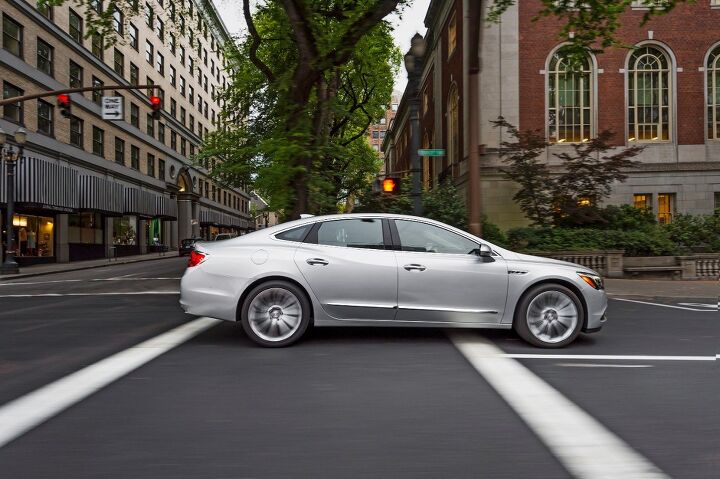The New Buick LaCrosse Is Already Fading Into Obscurity, Except On Dealer Lots
In 2016, as General Motors launched an all-new Buick LaCrosse for the 2017 model year, sales of the LaCrosse fell to an all-time annual low.
But wait a second. Transition years are difficult for any model. Clearance of the outgoing model ends, production of the new model is ramping up, availability at dealers is limited, and the product mix is often skewed toward less affordable models.
Nevertheless, cognizant of the fact that 2016 wasn’t likely to be a great year for the Buick LaCrosse, it’s still easy to declare that 2016 was an awful year for the Buick LaCrosse. Sales were 70-percent lower last year than in 2005, when U.S. LaCrosse sales peaked. Even compared with 2014, U.S. LaCrosse sales were nearly chopped in half in 2016.
And at the current pace, 2017 will be much, much, much worse.
A PROBLEM
Across the board, previously released full-size sedans are struggling. Impala, 300, Charger, Taurus, Azera, Cadenza, Maxima, and Avalon sales are collectively down 24 percent, year-over-year, through the first one-sixth of 2017. That rate of decline is far worse than the 13-percent drop reported by the overall passenger car market.
But compared with early 2016 — not a period of particular LaCrosse health, remember — Buick LaCrosse volume is down 60 percent, a drop of more than 4,000 sales for the LaCrosse during the two weakest months of the year.
Those poor results could, theoretically, be perfectly acceptable to General Motors if the plan was always to move the LaCrosse upmarket and reduce fleet emphasis and decrease incentivization.
Indeed, that was the plan. GM has moved the LaCrosse slightly upmarket, emphasized the retail environment (total Buick fleet sales are down 81 percent this year) and decreased incentives.
THE OTHER PROBLEM
But times have changed, evidently more rapidly than GM anticipated. GM produced roughly eight out of every ten January/February Buick sales with utility vehicles, up from five out of every ten just one year ago.
As a result of GM’s desire to build LaCrosses like it’s not going out of style, there’s a massive disconnect between supply and demand. GM has nearly one year’s worth of LaCrosse inventory; roughly 20,000 cars in stock for a nameplate that has averaged fewer than 2,000 monthly sales over the last year and barely more than 1,300 monthly sales so far this year.
SOLUTION?
According to J.D. Power PIN data obtained by TTAC, Buick discounted the LaCrosse by an average of $4,105 per vehicle in February 2017. That may sound like heavy incentivization, but consider the fact that the segment average was $5,588, and the LaCrosse joins the Toyota Avalon at the lower end of the range.
Regardless of where the LaCrosse ranks relative to its competitors, the level of discounting clearly hasn’t been enough for Buick dealers to rid themselves of excessive supply.
So what does an automaker do with more than 11 months of inventory?
“We’re not going to telegraph our plans, but whatever we do will be designed to strengthen our brand and protect customer value,” Fowle says. We know production will sharply decrease once the second shift at the Hamtramck plant — and its 1,300 accompanying jobs — is cut in March, but that doesn’t solve the problem of existing stock.
The LaCrosse is clearly one Buick problem. Buick dealers have also lost chunks of volume because of the discontinuation of the entry-level Verano, sales of which plunged 85 percent to only 898 units in early 2017, a loss of more than 5,000 sales. Regal sales have also been chopped in half so far this year. Thus, despite Cascada growth and a 22-percent crossover uptick, Buick sales are down 19 percent this year and Buick retail volume is down 6 percent.
Yet Buick’s Fowle tells TTAC, “It’s a very exciting time for Buick,” pointing to continued growth from the Encore, early response to the Envision, and the upcoming arrival of a new Enclave.
The degree to which the failure of the new LaCrosse in America matters to the overall Buick picture remains relatively inconsequential, however. As we’ve said before, Buick is for China.
Timothy Cain is the founder of GoodCarBadCar.net, which obsesses over the free and frequent publication of U.S. and Canadian auto sales figures. Follow on Twitter @goodcarbadcar and on Facebook.
More by Timothy Cain
Latest Car Reviews
Read moreLatest Product Reviews
Read moreRecent Comments
- MaintenanceCosts An LA house is a much better investment.
- FreedMike That's a crudload of fast for that kind of money. I wonder if you can shut off the one pedal driving system.
- Tassos Elon’s father was my favourite boss. It’s a shame the wokes in South Africa took away his very-happy workforce. They were always free to leave, we just couldn’t guarantee their safety once they left.
- Tassos If I win this giveaway I will trade my poor but attractive neighbour for pickled herring and aluminum-free deodorant.
- Shipwright One point missed is that part (not sure how much)of the new plant will be built using foreign labour.




































Comments
Join the conversation
I'm actually considering a larger car such as the Impala, Cadenza, or even the Lacrosse. I just can't get over the bulbous backends the Impala and Lacrosse have.
Those responsible for cancelling the Verano should be forced to wear a dunce cap. Officially 2016 was Buicks worst year ever for retail sales in the US. The Camry alone outsells the entire Buick division by nearly a 2 to 1 margin. This year Cadillac and even Lincoln are not that far behind Buick in sales.